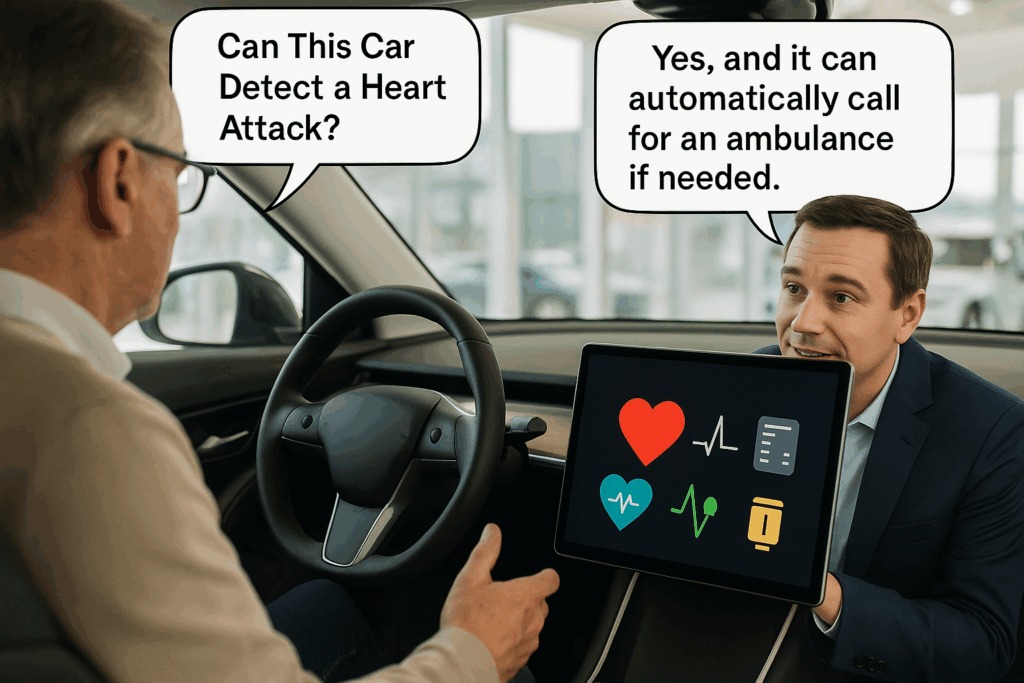by: Lawrence Harte
Connected vehicles can save and improve lives by including health and wellness monitoring apps that use devices, equipment and software that is already in the vehicles. Medical emergencies contribute to approximately 1.3% of all vehicle crashes, with heart attacks and strokes responsible for over 14% of those incidents. Many connected EVs are already equipped with video, audio, and proximity sensors capable of detecting signs of medical distress and triggering alerts for conditions such as heart attacks and strokes. These systems not only help prevent accidents but also enable early intervention, reducing the severity of medical events and improving outcomes. This article explores the technologies, services, and life-saving benefits of wellness monitoring in connected EVs.
Vehicle Wellness Monitoring Benefits
Vehicle wellness monitoring provides a wide range of benefits across the automotive ecosystem. These include improved driving safety, rapid detection of medical emergencies, automated assistance requests, smart routing to medical facilities, real-time health updates to support contacts, and potential insurance rate reductions.
For drivers, wellness monitoring increases safety, reduces stress, enhances comfort, and encourages better driving habits. Fleet managers benefit through reduced accident risks, improved driver productivity, and early detection of health-related issues among employees. For automakers, wellness features offer competitive differentiation, stronger customer loyalty, regulatory compliance, and new revenue streams via wellness-focused subscription services.
Driving Safety
Wellness monitoring systems improve driving safety by detecting signs of fatigue or distraction and issuing timely alerts to help prevent accidents. Additionally, health-based driving restrictions can be triggered, such as automatically recommending rest stops or temporarily limiting vehicle operation when unsafe conditions are detected based on biometric data.
Rapid Medical Emergency Detection
Advanced biometric sensors and AI in connected vehicles can identify early indicators of serious medical conditions like heart attacks or strokes, enabling a fast response. This early detection capability is crucial, especially for time-sensitive emergencies like strokes where prompt intervention can significantly reduce long-term harm or save lives.
Automatic Medical Assistance Requests
In the event of a medical emergency, vehicle wellness systems can automatically contact and request emergency services, sharing real-time health data and precise vehicle location. These systems can also be linked with electronic health records or wearable medical devices to provide responders with vital medical history, enhancing evaluation and treatment accuracy.
Smart Medical Routing
When a medical issue is detected, the connected vehicle can suggest or autonomously navigate to the nearest appropriate healthcare facility, helping ensure timely access to care tailored to the condition at hand. If the vehicle has self-driving capability, it may automatically drive itself to a medical center even if the driver is unconscious.
Health Contact Notifications
If a serious health event is identified, the system can automatically notify pre-selected family members or caregivers, offering peace of mind and quicker support response. These alerts, combined with personalized wellness feedback such as reminders on hydration or posture, enhance both safety and daily wellness for drivers.
Insurance Rate Reductions
Many insurers already offer safe driver discounts when customers opt to share vehicle usage data. With the rise of wellness monitoring, insurers are likely to further reduce premiums based on driver alertness verification, lowered accident risk, and potential reductions in medical costs, making these systems financially beneficial as well.
Wellness Monitoring Devices in Connected EVs
Modern connected electric vehicles (EVs) come equipped with video, audio, proximity, and other biometric sensors. By leveraging apps and AI-driven services integrated into existing vehicle software platforms, these systems can deliver effective wellness monitoring.
 Steering Wheel-Integrated Biometric Sensors
Steering Wheel-Integrated Biometric Sensors
Steering wheels or arm rests can serve as good touchpoints for wellness data collection, offering constant physical contact with the driver. Touch-sensitive steering wheel sensors are capable of measuring grip strength, skin conductivity, and pulse rate. These metrics can indicate stress levels, fatigue, or physical weakness, enabling real-time health assessments.
In-Cabin Video Monitoring with AI and Thermal Imaging
Many advanced EVs now include in-cabin cameras that can use artificial intelligence to interpret the driver’s physical state. These systems track eye movement, head position, and facial expressions to identify early signs of fatigue, distraction, or drowsiness. Some go further by incorporating facial recognition and thermal imaging cameras, which can detect heart attacks, strokes, seizures and other medical emergencies.
Audio-Based Voice Stress and Breathing Analysis
Microphones embedded in the cabin can serve more than just entertainment or voice assistant functions—they can analyze speech patterns for indicators of emotional or cognitive stress. Voice stress analysis, powered by AI, interprets changes in tone, hesitation, and breathing to assess fatigue or anxiety. Audio AI analysis can identify respiratory distress such as Asthma, COPD, Allergic Reactions or other medical issues.
Spatial Awareness and Ultra-Wideband (UWB) Monitoring
Spatial monitoring inside the vehicle uses technologies like ultra-wideband (UWB) radar to track occupant positioning and motion. These systems can detect whether the driver or passengers are in unusual positions—such as slumped over—potentially indicating a fall, seizure, or loss of consciousness. UWB-based movement monitoring is especially valuable for elderly or high-risk drivers, as it can initiate automated responses (like contacting emergency services) when abnormal motion or inactivity is detected.
Integration with Fitness Wearables and Glucose Monitors
Connected EVs can have the ability to sync with health-focused wearables like Fitbit, Garmin, or Apple Watch, integrating real-time biometric data directly into the vehicle’s wellness platform. This includes heart rate, skin temperature, sleep cycles, and stress indicators. Vehicles may also be able to connect with Continuous Glucose Monitors (CGMs). These integrations create a seamless bridge between personal health management and vehicle safety systems.
Additional Health Monitoring Accessories
Beyond built-in systems, several wellness accessories can be installed or temporarily placed in the vehicle to enhance monitoring capabilities. An armrest-integrated blood pressure monitor or steering wheel heart rate sensor can provide cardiovascular data without needing the driver to use external devices. ECG sensor pads embedded in seatbacks or seatbelts allow for electrocardiogram monitoring, while SpO2 sensors on fingertips or wrist clips measure blood oxygen saturation—critical for detecting early signs of respiratory distress or hypoxia.
Connected Vehicle Wellness Services
As vehicles become more connected and intelligent, they are increasingly capable of delivering real-time wellness services that promote occupant safety, comfort, and health. Wellness data collected from in-vehicle sensors, wearables, and monitoring accessories is processed through onboard systems and cloud-based platforms.
Real-Time Wellness Alerts and Personalized Interventions
Connected vehicles can analyze driver biometrics and behavioral data to deliver timely alerts and insights that enhance safety and reduce health risks. For example, drowsiness detection systems use eye tracking, posture monitoring, and steering behavior to issue real-time audio or visual warnings when signs of fatigue are detected. These alerts often suggest rest breaks or trigger adjustments to help maintain alertness.
Automated Emergency Response Integration
When a connected EV detects a serious health issue, such as abnormal heart rhythms, respiratory irregularities, or a loss of consciousness, the system can automatically initiate emergency activities and requests. These may include safely bringing the vehicle to a controlled stop and triggering an emergency call to local responders. The vehicle can also transmit critical medical information, such as known health conditions or live biometric readings, to emergency personnel en route.
Health Status Sharing and Communication
Beyond emergency detection and response, connected EVs can play a central role in health communication and coordination. If an incident occurs, the vehicle can automatically notify family members, caregivers, or designated support contacts through text messages, app alerts, or emails. These updates may include the location of the vehicle, the nature of the health event, and whether emergency services have been contacted.
In scenarios where the occupant is unresponsive or unable to use their phone, this feature ensures that loved ones are kept informed and can take action or provide guidance. Additionally, some systems offer the ability to share ongoing health status updates with healthcare providers or fleet safety managers to facilitate post-incident follow-up and wellness monitoring.
Wellness Monitoring Challenges
Wellness monitoring also introduces a complex set of challenges. While the integration of biometric sensors, AI analysis, and cloud-based health reporting can greatly improve safety and medical response, these technologies must operate within ethical, legal, and user-centric frameworks.
Privacy and Data Security
One of the most critical challenges in vehicle-based wellness monitoring is the protection of sensitive health data. Biometric information such as heart rate, facial expressions, stress indicators, or medical alerts must be encrypted during storage and transmission to prevent unauthorized access or misuse. This data should also be anonymized where possible and only collected with clear user consent, in accordance with data privacy laws like GDPR and CCPA.
Wellness Monitoring Accuracy
Wellness systems must be carefully calibrated to minimize false positives—overly sensitive alerts that may disrupt driving, cause unnecessary panic, or trigger automated interventions such as calling emergency services when not warranted. Ensuring a balance between responsiveness and accuracy is key to creating systems that are both effective and trusted.
Navigating Legal and Regulatory Compliance
Wellness monitoring in vehicles may incorporate medical-grade biometrics and health data which have complex regulations. This includes health data protection laws, medical device classifications, and transportation safety regulations, which may vary by region and jurisdiction. For example, if a vehicle system collects or transmits medical-like data (e.g., ECG or blood pressure readings), it may fall under healthcare regulations such as HIPAA in the United States or the MDR in Europe.
Building and Sustaining User Trust
Gaining and maintaining user trust is essential for the long-term success of wellness monitoring technologies in EVs. Drivers and passengers must feel confident that their health data is being handled transparently and ethically. This includes providing users with control over when and how their data is collected, stored, shared, or deleted. Clear, user-friendly interfaces that explain what data is being used and for what purpose can help bridge the gap between advanced technology and consumer comfort.



 Steering Wheel-Integrated Biometric Sensors
Steering Wheel-Integrated Biometric Sensors